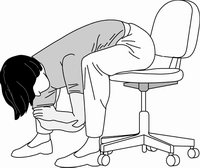1. Expecting Someone Else to Lower Your Stress Level
It is tempting to blame
others for your stress—your boss or your supervisor, perhaps—and if they
are to blame, then you might expect them to change or rescue you from
your predicament. Keep in mind that changes or decisions created by top
management are typically reactions to external events. It is likely that
managers are trying to respond effectively to outside forces such as
economic downturns, stiffer competition, marketplace shifts, or new
technological advances. The changes they have wrought make sense from
their point of view, and it is unlikely that they will backpedal just to
make life easier for you. If they stagnate, it may ultimately be worse
for you and your organization in the long run.
Blaming others for
your situation further damages your sense of control, for you view
yourself as a helpless victim without alternatives or choices. Blaming
also triggers anger and the release of stress hormones that can damage
your health and deplete your energy. It is unrealistic to expect someone
other than yourself to rescue you from a stressful job situation or
protect you on the job. Your bosses are too busy taking care of
themselves and they, no doubt, feel as much or more stress than you. You need to take charge of managing the pressure, for ultimately you can only count on yourself to lighten your psychological load.
How do you go about
doing this? First, assess whether you can take any reasonable steps to
change the stressful conditions. If so, then take those steps. If not,
then two choices remain: (1) adapt to the situation, or (2) find another
job. Oftentimes adapting just requires a change in your perspective.
Try to put yourself in your boss's shoes
to understand why certain changes or new practices are necessary, even
if you don't like them. And recognize that you are never really trapped.
Your choices may be difficult, but choice always exists. You can weigh
the pros and cons of staying with your job and learning to adjust if the
pros weigh heavier, or you can begin searching for a new job if the
cons win out.
2. Assuming That You Can Resist Change
It has often been said that “the only constant is change.”
You can attempt to resist change in the workplace, either consciously
or unconsciously, directly or through passive-aggressive maneuvers. If
you resist, you may decrease your anxiety or stress level in the short
run, but in the long term you are setting yourself up for greater stress
and eventual failure. The very act of resisting change is in itself
stressful, and may prove more difficult for you than going with the
flow. Many people waste far more energy clinging to old habits than it
would take to accept and adapt to the changes. Fighting change is almost always a losing battle.
Can you really expect to succeed in your job, in an ever-changing
world, if you keep doing the same old things in the same old way?
The same thing applies if
you decide to accept the need for change, but only at your own pace and
according to your own schedule. Here the goal is to minimize stress by
“pacing yourself.” While this may be well-intentioned, it can often
backfire. Why? Because failure to keep up with your organization's rate
of change is still resistance, however well-intentioned. You can slow
things down for other people, cause backlogs for yourself and others,
and risk the wrath of your superiors. If you are the boss, then you run
the risk of falling behind your competitors.
You need to keep in
step with the intended rate of change deemed necessary by your
organization or your competitors. Some people, if allowed to go at their
own pace, would take forever to change. If you lag behind you will
eventually have to play catch-up, and there is no guarantee that you can
successfully close the gap. Remember—you may not have control over the
type or speed of changes thrust upon you, but you always have control
over how you choose to react to the need for change.
However, the whole
notion of “pacing yourself' on the job to lower stress is a good idea,
but only if you pace yourself in the right way. Pacing yourself properly
can enhance productivity and lower stress. Pacing yourself wisely is
not a matter of slowing down, but rather using strategic planning for
structuring your time. Here are some pacing tips that will enable you to
recharge your batteries, revitalize yourself, and ultimately be more
productive and creative.
Pay
attention to your natural body rhythms to determine at what times you
function at your best. Are you a morning person or a night person? When
possible, schedule your most difficult tasks for your peak performance
hours. Try to avoid tackling difficult or exhausting projects during the
part of the day when your energy is at its lowest.
Shift
between pleasant and unpleasant tasks. After finishing a difficult
piece of work, switch to something mindless, easy, or pleasant.
Allow
some time each day, even when you are swamped with work, for
pleasurable work tasks, even if they are not highly productive.
Use your breaks and lunches to relax. Do not work over lunch unless it is absolutely essential.
Take
mini-breaks for three to five minutes throughout the day to relax and
balance yourself. Talk to a co-worker, have a refreshing drink, and so
on.
Choose
leisure activities that balance the unique stresses in your line of
work. For example, if you deal with people's complaints all day long,
choose solitary, peaceful pursuits. Or if you are cooped up in a
windowless office all day, choose outdoor activities. If you work alone,
make sure your leisure time includes social activities with friends.
Take
vacations. Carefully consider the length and type of vacation you plan
in order to balance work stresses. If your work is very sedentary, plan
an active vacation. If your work is physically exhausting, plan a
vacation where you allow a good amount of time for just kicking back and
relaxing. If you work alone and feel lonely, visit friends or family or
vacation with others.
If possible, take a break during your workday to exercise, do relaxation practices, or run an errand. The following six stretches are
specifically designed for the workplace, to be done at your desk in your
chair (Marshall, 1999). Take a few moments daily to do one or more of
these stretches when you feel tense or fatigued, and notice the results.
Chair Twist
Sit toward the front
of your chair. Swivel your thighs toward the right side of the chair so
you are sitting diagonally on the seat. Inhale and lift your right arm
up to the ceiling. Exhale and move your arm to the back of the chair on
the opposite side, taking hold of the chair back. Bring your left hand
to your right knee. Inhale and lengthen your spine. Exhale and twist to
the right, pressing your right hand against the back of the chair to
deepen the twist. Breathe into your rib cage. Relax the muscles in your
back and gently twist a little farther. Stay in the pose for four to six
breaths. Return to your center with an inhalation and repeat on the
opposite side. (See Figure 1.)
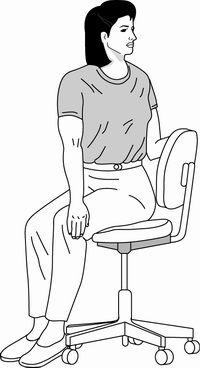
Shoulder Rolls
Sit upright and
inhale while lifting your right shoulder to your ear. Exhale and slowly
roll your right shoulder forward, around and back, dropping it away from
your ear. Continue these shoulder rolls three more times, alternating
right and left. Inhale as you lift both shoulders up to your ears.
Exhale as you release them. Repeat the shoulder lift five times and then
relax your shoulders. (See Figure 2.)
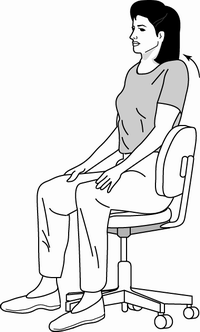
Side Stretches
Stand with your
feet parallel. Inhale and stretch your arms out to your sides and
overhead, with your palms facing away from your body. Exhale while
holding your left wrist with your right hand and then inhale. Stretch
the fingers of your left hand toward the ceiling. Exhale and stretch to
the right. Pull your left arm with your right hand. Keep your left arm
and head straight. Breathe softly as you stretch. Inhale as you come
back to the center. Exhale and switch hands, holding your right wrist
with your left hand. Inhale as you reach up through the fingers of your
right hand. Exhale while stretching left and inhale and return to the
center. Repeat this sequence on each side. (See Figure 3.)
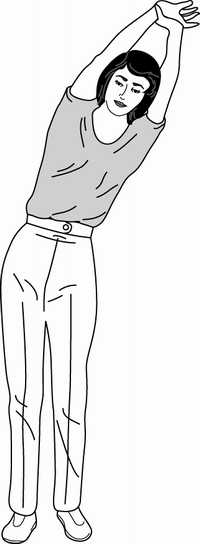
Open Chest Stretch
Sit near the edge of your
chair. Interlace your fingers behind you, palms facing your back. Lean
slightly forward. Lift your arms and rest them on the back of the chair.
Inhale and lift your chest. Exhale and relax your shoulders away from
your ears. If your hands do not reach the top of the chair, clasp the
sides of the chair back and press your chest forward, relaxing your
shoulders and opening your upper chest. Hold this position for three to
six breaths. With an exhalation, slowly release your hands and bring
them down by your sides. (See Figure 4.)

Neck Stretches
Sit upright, with
your head aligned with your spine. Inhale and on exhalation, drop your
right ear toward your shoulder without lifting the shoulder or turning
your head. You can use your left hand to gently assist your head and
neck in stretching toward your right shoulder. Take several breaths in
and out. Gently massage your neck and shoulders with your left hand.
Slowly lift your head and switch sides to repeat the sequence. (See Figure 5.)
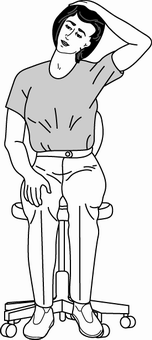
Back and Shoulder Release
Part One:
Sit on the edge of your chair, placing your feet about
two-and-a-half feet apart, parallel to each other. Lean forward and
place your forearms on your inner thighs. Press your inner thighs out
with your forearms. Breathe deeply in and out.
Part Two:
Make sure your knees are directly over your heels, and your feet
are parallel to each other. Slowly stretch your arms down toward the
floor. Rest your ribs on your thighs and your armpits on your knees.
Cross your arms, placing your hands at the opposite elbows. Continue to
breathe deeply. (See Figure 6.)
